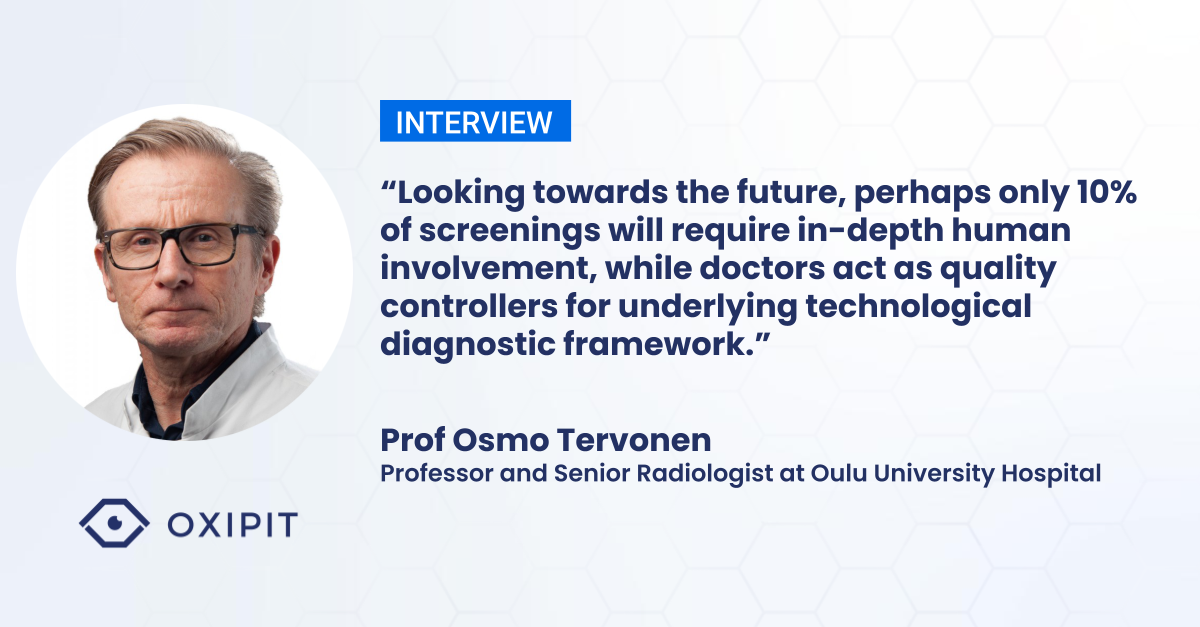
Prof Osmo Tervonen is a professor and a senior radiologist at Oulu University Hospital in Finland. He is also a partner in Parasmed – a Nairobi based medical device distributor, which provides access to emerging medical technologies to the countries in the East African region.
In his interview with Oxipit, prof Tervonen shares his views on AI in healthcare and AI’s role in the field of value based medicine.
At Oulu University Hospital you were among the early adopters of Oxipit AI medical imaging software. What enticed you to trial it in the first place?
I was certain that AI will change the way how things are done in medicine, especially in diagnostic imaging.
I was attracted to this field in scientific, as well as philosophical terms. AI gives us certain insights on the inner workings of our brain, where intelligence and consciousness is hiding. Perhaps it is the first time in history where we have this outside mirror to look inwards.
Basing the ideas on the works of Ludwig Wittgenstein, or Kurt Gödel and Alan Turing who advanced the thought towards mathematical description for reality, and by combining philosophy with math, we can describe the world in an exact way.
What was your experience with AI deployments so far and AIs impact on medical imaging workflow?
When I am teaching medical students, I am priming this concept that doctors will become quality controllers for AI systems. Take medical imaging as an example. Most of the time it is routine screening. You do not need human brain capabilities to deal with routine things.
Looking towards the future, perhaps only 10% of screenings will require in-depth human involvement, while doctors act as quality controllers for underlying technological diagnostic framework.
We have trialed AI software for reporting plain chest radiographs, which is the most routine task in medical imaging. In addition, we are discussing a new framework for screenings in an emergency setting, where we could benefit from rapid AI responsiveness. Also the primary care setting, where most of the cases feature no abnormalities.
Considering your experience with Parasmed, what are the differences for AI adoption in developed and the developing country setting?
I recently read a study on Kenyan radiologist opinion towards AI. While as in the developed countries a few of them had firsthand experience with AI tools, yet the general acceptance is more positive. AI in healthcare could present a leapfrog technology for the developing world, which could help bridge the gap of quality of care.
If you take large urban areas like Nairobi as an example, you have many similarities to a developed country setting. Here the primary goal for AI tools could be routine quality control of diagnostic performance.
Radiology specialists are hard to come by in rural and remote areas. However, there is an additional roadblock in terms of infrastructure: using film for X-ray, no PACS platform or lack of connectivity between systems.
In addition, you need a high trust society to advance medical care. We aim for successful local pilots of AI solutions and local advocacy to support wider adoption.
Five years ago the general media narrative said that AI will leave radiologists broke and jobless. Things have not turned out that way. On a more serious note, are you satisfied with the pace of AI? Are we there where we expected to be?
I was very optimistic 5 years ago, when I was applying for research grants. Safe to say, everything is not moving as fast as we expected. Yet I don’t think AI is to blame.
The speed of change has more to do with the healthcare system, the way of thinking here. More advancements should be taken towards value based medicine, where the quality of service, availability levels, costs and patient outcomes should all be taken into account.
Can AI outperform a radiologist? The framing of this question is wrong. In certain cases it can, in certain it cannot. Yet it is an impossible task to hunt for the perfect score and the perfect AuC percentage. Being 100% right all the time is not the point. We have to calculate the always-on rapid availability in certain settings, routine task automation in others, cost aspects, and measure holistically whether quality of care and patient outcomes are affected.
I would consider a controlled study in terms of how low AuC performance can go before any impact on quality of care or patient outcomes are noticeable. Fixation on diagnostic perfection is self-defeating. It is only a single point in a value chain of healthcare decisions, protocols and services.
AI can already play an important role in value based medicine. And it is up to the next generation of medical specialists and healthcare managers to consider the big picture and make this transformation.



